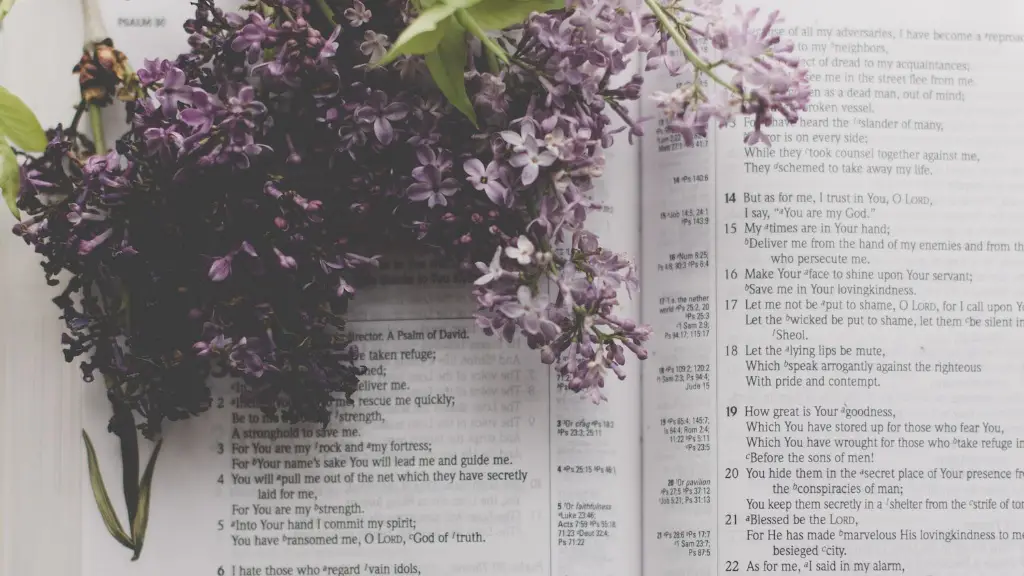Background
The character of Hagar is introduced in the Bible in Genesis Chapter 16. She is an Egyptian concubine, or secondary wife, of Abraham. Through a promise from God, she is said to have had a child, Ishmael, with Abraham. Ishmael later became the progenitor of the Arabs. This makes Hagar not just an important character for Hebrews, but for Arabs and Muslims, too.
Outside of Bible narratives, Hagar is not well-known. Even though she is important in early Hebrew texts and her story is recounted, it is not her life but her struggles and her relationship with Abraham that are emphasized.
Roles and Assumptions
Prior to God’s intervention, Hagar was no more than an item of property for Abraham. Bible scholars have argued that she was Abraham’s second-in-command, which implies her status as an exalted concubine. At God’s command, she became a matriarchal figure. As a result, even though she was a slave, her son’s legacy was a blessing brought about by God for the Hebrews.
Hagar is seen in many ways: on the one hand, she is viewed as an outsider, a woman in a patriarchal society, with very few rights and privileges. On the other hand, she is seen as a model of obedience and courage, and as a woman of faith. The roles and assumptions attached to Hagar have been tied to religious views: as a figure in a Bible story, she carries with her complex religious significance.
Impact in Jewish and Christian Tradition
The legacy of Hagar has played a role in the tensions and conflicts between Jews, Christians and Muslims since early times and continues to do so today. This has led to discussions, debates and heated opinions regarding not only her character, but her actions and their interpretation.
For Jews and Christians, Hagar is a figure of faith and hope. She is seen as a symbol of fidelity and servitude to God, and is portrayed in Christian art as a triumphant figure holding a palm branch and a cross. For Muslims, Hagar is seen as a matriarchal figure, and a proof of the prophethood of Abraham and a symbol of the power of women.
Interpretation
The story of Hagar is often interpreted differently among various religious audiences. Even though the characters and the events of the story remain unchanged, the details vary according to each religious opinion.
For example, in the Orthodox Jewish tradition, Abraham is often seen as an all-compassionate leader and Hagar, as a humble servant. In contrast, other countries of the Middle East tend to see Abraham a little differently and Hagar in a much more positive way – as a woman of strength and courage in a world dominated by men.
Cultural Significance
Due to her diverse and complex roles, Hagar’s character has been interpreted by many cultures: she is represented in art, literature, music and film. For many, she represents a figure of hope and perseverance in times of struggle and strife.
In literature, Hagar has featured as a character in works by Pearl S. Buck and Anita Diamant, and as a major figure in Alice Walker’s 1982 Pulitzer Prize-winning novel The Color Purple. In popular culture, the story of Hagar has been the subject of TV shows, soap operas, and even music videos.
Knowledge, Wisdom and Faith
Hagar is remembered as an example of faith in the face of adversity. Through her story, many lessons appear: knowledge, wisdom, and faith. As a woman, she is a symbol of knowledge and wisdom – her actions often defy the expectations of her time. At the same time, her story stands as a reminder of the importance of having faith, even in the darkest of times.
Hagar’s story has been used as a tool to teach generations of people about the importance of faith, trust and courage. For many, her story is a reminder that despite one’s circumstances, it is possible to find strength, even in the face of adversity.
Faith in the Middle East
The story of Hagar is relevant not only to Western religions, but to Middle Eastern religions as well. For example, in Islam, the Quran recounts her story and celebrates her as a symbol of faith and hope in a troubled world. In Hagar’s story, many see a reminder of courage, resilience and fortitude in the face of suffering.
Continued Relevance
Hagar’s journey of faith and struggle reflects the ongoing tensions and issues faced by Middle Eastern countries today. This is why Hagar continues to be relevant, centuries after her story was first recounted in the Bible. Despite the changes in culture, customs and values, her story continues to inspire generations of people.
Hagar’s story conveys a message of hope and courage, even in the face of adversity: it is a reminder that strength and faith can overcome many difficulties. Hagar stands as a reminder that even in the midst of turmoil, if we trust in God, we can find joy and courage in our struggles.
Sacrifice and Endurance
The story of Hagar not only demonstrates faith, but also illustrates sacrifice and endurance. In spite of her difficult circumstances, Hagar remained faithful to God and persevered even when the odds were against her.
Her example of resilience and determination is an inspiration to countless generations of people. She stands as a reminder that even in the face of difficulty, we can remain steadfast in our faith and that God rewards those who are unwavering in their devotion.
A Symbol of Strength
Hagar’s story has inspired and influenced believers of many religions. Despite her uncertain status in a patriarchal society, Hagar remains an important figure in religion and culture. Her strength, resilience and courage in the face of adversity serve as an example to many who face similar challenges in their own lives.
Her story reminds us that even in the darkest of times, there is always hope and the possibility of joy if we have faith and courage. Hagar stands as a symbol of hope and perseverance for many today, for whom her story is as relevant as it was thousands of years ago.



My name is Patrick Hobbs and I am in my 95th year of life.
As a brief background, I was of an average English family, raised in the Church of England, said nightly prayers kneeling at my bedside of the ‘God bless mummy and daddy’ sort and became a probationary chorister at the age of seven until eventually I was forced to give up when my voice broke at age 12. Thus, with three weekly attendances for choir practices plus Sunday Holy Communion and Evensong services, weddings and funerals, I was well acquainted with the House of God as I grew up yet, strangely, and in spite of also attending Sunday School, never felt I had been inspired or that knowledge had been imparted of the existence of Jesus Christ.
I now reflect, in later life, that this failure to teach children convincingly of the very basic historicity and existence on earth of Jesus of Nazareth as a sine qua non for His crucifixion and resurrection, leading to the the spread of the Christian religion, may well be the reason there are not many more Christian believers. Jesus emerged as almost mythical rather than incarnate.
I have now, late in my life, experienced an inspirational, undeniable and direct message from this ‘unknown’ God which I feel compelled, as an apostolic duty, to share with you.
In my search for God I read, and was inspired by, theological and scholarly books from the likes of C S Lewis, N T Wright and others. In seeking greater certitude, I then ventured, if somewhat presumptuously, in my prayers one night to ask God to give me, as ‘a humble truth-seeker’, a sign of his existence. This brought about a personal direct communication with an existential God.
Approximately two to three days after my prayer, I had a vivid dream but this one, unlike many, remained vivid after I woke.
Firstly and briefly there appeared a moving, hooded figure carrying the cross. The face was an indistinct blur. The top half of the cross only was visible and the hand was clenching and unclenching against the patibulum. This lasted but a few seconds before the scene changed to me, as a younger man, clambering over a brick wall to enter a garden which was entire rubble and needing urgent attention. It was attached to a modest suburban weatherboard house that my wife and I were preparing to move into.
Some years ago, when we were living in my birthplace, England, I employed a gardener who cared for our large garden and it was he, old George, who appeared on the scene and, as dreams are able to accomplish, the land was shortly transformed into rows of orderly mounds of soil each with healthy green shoots sprouting from each peak. It then evolved into this extraordinary narrative.
George asked if he could hang garden ornaments to the wall and, in particular, the cross and crucified Christ he had seen hanging on the trellis at his local plant nursery. I agreed, went myself to the nursery, located and purchased the crucifix. Across the shoulder and upper body of Christ however was a sash and printed prominently on it a strange word completely and utterly foreign to me – HAGAR.
I woke, my mind totally engaged and mesmerised by my dream, and rummaged in a drawer for a pencil and piece of notepaper on which I write items to review when I am reading and, in the half-light, I printed large across the page the letters ‘HAGAR’ to ensure preservation for the next morning’s research into the meaning of this mysterious word.
This, in turn, led me by chance to your website and an understandable compulsion to now share this extraordinary dream with you.
You will be aware through your intimate knowledge of the scriptures that Genesis 16 and 21 describe how the slave girl, Hagar, produced Abraham’s son, Ishmael and I was deeply overwhelmed to read how her life teaches us that God answers prayer and keeps his promises.
I can see no rational explanation as to how I could be so confronted by an ancient and obscure biblical name, one that I could never have possibly come across, not having read or even opened the first page of the Old Testament.
My conviction is most surely justified in that, had the dream contained only images, such as indeed actually happened by firstly seeing the ‘introductory’ visualisation of Christ carrying the cross, it would have been interpreted as unexceptional. A truly convincing message from God could only, and indeed was, delivered by linking me to him through a completely unknown name which could not possibly be re-created by my conscious or unconscious mind other than through some ethereal influence. The two combined manifestly sent an answer to my prayer.
In relating this story to others I am aware that there are many extraordinary stories that, despite being of profound personal significance, will always find those who will understandably find an explanation that I had previously somehow heard of Hagar which had resurfaced in my dream. I can do nothing to overcome such doubts but, in a sense, draw strength and validation from such thoughts since it is indeed a wholly incredulous yet clear answer to my prayer which has given me a belief and faith to inspire my remaining years.
That is my story.
I feel most profoundly blessed and write to you in the hope it may inspire others seeking confirmation of the truth.
Patrick Hobbs e: [email protected]
Rose Bay Sydney Australia